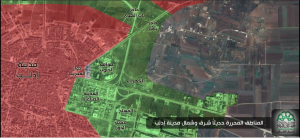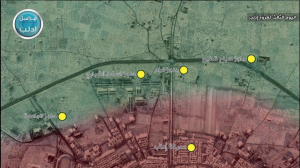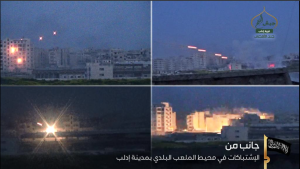Jaysh al Fateh, the jihadist coalition established for the battle of Idlib, has captured more than a dozen checkpoints from Syrian regime forces. The alliance’s member groups have posted a steady stream of propaganda online after launching the offensive earlier this week. The propaganda messages — including maps, videos, and pictures — show the jihadists controlling key checkpoints and other ground in and around the city.
The population of Idlib is estimated to be greater than 100,000 people. If the city falls to the jihadists, it will be one of the most significant victories for the anti-Assad rebels, who are not aligned with the Islamic State, since the beginning of the war in Syria.
Abu Bakr al Baghdadi’s self-declared “caliphate” captured a large amount of territory from both rebels and the regime in northern and eastern Syria. And the Islamic State has held Raqqa as its de facto capital for some time.
But Jaysh al Fateh’s member groups are opposed to both the Islamic State and Bashar al Assad’s regime. Should the city of Idlib fall to the jihadists, it will consolidate their control over a significant portion of northern Syria. The Al Nusrah Front, al Qaeda’s official branch in Syria, previously captured a number of towns and villages from Western-backed rebels late last year and earlier this year.
Al Nusrah is using weapons seized from those other rebel groups, including American-made TOW missiles, to take out Syrian regime tanks that were positioned around the city. Suicide bombers from multiple groups also executed large-scale attacks on regime forces stationed at the checkpoints. The suicide bombings, and the shock troops who followed, were intended to force Assad’s security forces to flee.
In addition to Al Nusrah, the Jaysh al Fateh coalition includes Ahrar al Sham, Jund al Aqsa, Liwa al Haqq, Jaysh al Sunna, Ajnad al Sham, and Faylaq al Sham, among others.
The Islamic Front, which is led by Ahrar al Sham, posted the map seen on the right on its official Twitter feed.
The map shows Ahrar al Sham’s forces, colored in green, advancing on Idlib from the east. Various key civilian facilities have fallen to Ahrar al Sham during its push into the city, including administrative buildings and grain silos.
One Ahrar al Sham video purportedly includes footage of the organization’s fighters evacuating civilians from Idlib, while other photos show the jihadists advancing toward the heart of the city.
Still another photo shows a picture of Bashar al Assad and a number of small Syrian flags scattered on the floor of an outpost that Ahrar has taken over.
The Al Nusrah Front has also posted a map, seen on the right, of its fighters advancing from the north.
In addition, the al Qaeda branch has published photos of its fighters in control of some of the checkpoints pictured in the map. Early in the battle, Al Nusrah launched a suicide bombing using a vehicle at the Al Ram checkpoint, which is one of the outposts the jihadists overran.
A video posted online by Al Nusrah shows its fighters battling Syrian regime forces and Assad’s Iranian-backed proxies near a housing complex. A second video shows Al Nusrah in control of the same complex. Al Nusrah has released photos of tanks destroyed during the battle as well.
Jund al Aqsa, another group in the Jaysh al Fateh alliance, has posted a stream of photos and messages on its own Twitter feed. One set of pictures (seen on the right) captures the fighting at a stadium in Idlib.
The bodies of slain Syrian fighters, captured tanks being used by the jihadists in the battle, and a precision strike on security personnel are all also pictured on Jund al Aqsa’s Twitter feed.
Suicide bombers from Jund al Aqsa took part in the initial wave of attacks on the regime’s checkpoints outside of Idlib.
Jaysh al Fateh issues guidelines for fighters
On Mar. 25, Jaysh al Fateh’s sharia committee issued guidelines addressing how its fighters should behave during the invasion of the city. The 10-point Arabic statement shows that the coalition is confident its jihadists will “conquer” the city this time, even after failing to hold key points in Idlib in the past.
The authors of the statement begin by writing that the citizens of Idlib are “our people and our supporters.” The jihadists hope to “free” them from the “oppression” of the Assad regime.
The coalition’s fighters should avoid shelling targets “from within” the city unless precision weapons are needed to strike back at regime forces. Even then, the “sharia and military officials” will determine which strikes are necessary.
Jaysh al Fateh’s members are to avoid terrorizing the people of Idlib, while focusing their violence on those who defended the Assad regime. The jihadists must not “terrorize” the inhabitants of the homes they search through, and the children of Assad’s supporters are to be left unharmed. Jaysh al Fateh cautions its fighters to abstain from punishing the fathers of the children in front of them as well, because the children have “no connection” to their fathers’ deeds.
The statement includes links to rulings on the “wealth and lives” of Christians, drawing on previous opinions issued by jihadist ideologues. Jaysh al Fateh urges its men to preserve as much of the city as possible, without destroying it.
Finally, Jaysh al Fateh calls on the people of Idlib to stay in their homes during the battle and also to reveal the locations of Assad’s supporters stationed in the city.
The statement reveals that Jaysh al Fateh plans on ruling Idlib in the near future. The coming days will tell if the coalition can clear the city of Assad’s forces and then hold onto it.











1 Comment
great news